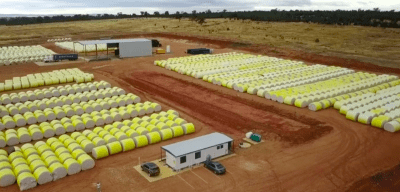WEILIN Trade is adding a new dimension to Australia’s cotton industry by exporting cotton round bales, seed and all, in containers from its facility at the Western Riverina Intermodal Freight Terminal (WRIFT) at Wumgulbal near Griffith in southern New South Wales.
Weilin holds Australia’s only seed cotton export licence which, coupled with Chinese Government approval for its parent, Weilin Group, to import raw cotton, has allowed it to establish a fast and efficient way of getting Australian cotton, and cottonseed, into China.
Trade sources said this season Weilin shipped around 2000 round bales of seed cotton in this manner, the equivalent of almost 2000 tonnes of lint, from WRIFT for Chinese free-trade zone ginning.
Weilin Trade was established by the Weilin Group (China) in 2012. While it initially focused on raw cotton exports, it evolved last year into a merchant business to source ginned cotton for China, and had already purchased 20,000 bales of 2018 cotton.
Weilin also grows cotton on its 8870-hectare Noonameena aggregation at Coleambally in the Riverina, and is exporting its own as well as other growers’ ginned and raw cotton via WRIFT’s rail connections to Sydney and Melbourne.
Warm reception
The company has created a straightforward way for growers in southern NSW to market their cotton, and obtain payment within a lightning-fast 48 hours of sampling, analysis and receiving bales from the field.
“If you are cash-flow stuck, it’s the way to go,” one trader said.
“It is not a bad deal for the growers — it is quite favourable to them.”
Weilin appeared to provide a fair price per bale, calculated on lint core sample, seed value and estimated out-turn.
A trader said Weilin’s business model was seen as being capable of duplication in other cotton-growing areas, particularly those remote, such as potentially offering access to containerised shipments out of the North Queensland port of Townsville.
Cottonseed rollercoaster
It seems Weilin’s straightforward approach to purchasing cotton from growers found a sweet spot in the confusion of the 2018 cottonseed-marketing year.
While lint prices have been consistently strong, cottonseed prices have gone on a wild and drought-driven ride. During last summer lacklustre bids were set against the likelihood of high supply and regrettably low export demand.
Cotton growers in February were hesitating about accepting ginning contract terms which would incorporate cottonseed prices of $180-$200/t, beneath the threshold at which the sale of the seed would pay ginning cost, while market prospects looked bleak.
Although their seed portion would not pay for their ginning, autumn harvest of cotton was completed in ideal conditions which promoted exceptional lint quality and high yields.
The same cloudless seasonal conditions continued to create eastern Australia’s ongoing drought, which saw cottonseed prices climb in steps and leaps and turn cottonseed into a premium source of livestock feed in the face of grain, roughage and pasture shortages.
Values had recovered a little through ginning around Easter; one trader saying seed was available ex gin at $220/t in April. By August that seed value had climbed to $580/t. Much of the increase in seed price had occurred between late August and mid-September as further realisation dawned that next year’s cotton crop was in peril.
Seed exports on slow simmer
Australia had exported around 115,000t of 2018-ginned cottonseed to the end of July 2018, compared with 212,475t of previous season commodity shipped in the same period in 2017.
The quantities shipped each month during the marketing year to Japan and Korea have been relatively stable.
However, China’s demand fluctuated from nothing in some months to greater than 50,000t in other months.
During the peak ginning period, May, June, July and August shipments to China in 2017 accounted for 90pc of the total 265,000t cottonseed shipped from Australia to China in the 2017 cotton market year.
While the main destinations for Australian cottonseed typically are China, Japan and Korea, US west coast dairy farms, significant importers in past decades, recently are nowhere to be seen on account of relatively cheap feed ingredients available when the US soybean market collapsed early this year at the onset of US/China trade disputes.
New gene shrinks market
Since the introduction of Bollgard III cotton varieties, widespread adoption and huge agronomic success has been tempered by rising risk in exporting cottonseed.
Weilin’s shipments would be among the first cottonseed containing the defining Bollgard III gene, Vip3A, which was approved in February 2018 by the Australian Veterinary and Pesticides Medicine Authority, but has not received universal clearance for import into China by its Ministry of Agriculture and Rural Development.
Australian exporters, waiting for approval from China for import clearance of cottonseed containing Bollgard III technology, recognise the risk-premium traders need to reflect in purchases or sales.
A fluctuating risk premium makes it hard for any buyer or seller to receive clear market signals and is a disincentive to trade.
While 264,858t of Australian cottonseed was shipped to China during 2017, the first full year of widespread adoption of varieties containing the Bollgard III gene, traders said the majors in cotton had avoided direct trade in cottonseed with China for this reason.
This was despite the price incentive to book flat prices on sub-$200/t seed for export.
Traders said plenty of business had been booked for export, but as prices began to rise in March, more than half the priced volume was traded back into the market, and only some was taken through to execution.
First-time-user graziers come back for more
Because of the drought-inflated domestic market, further cottonseed exports of considerable volume are unlikely in 2018.
“Domestic cottonseed trade this year has seen many people use it for the first time,” RainAg cotton and grain market manager, Ian Grellman, said.
“There are a couple of factors which made this season different from previous droughts.
“Cottonseed was well priced at levels below wheat and barley and sorghum, not by much, but enough to make it attractive, and tonne for tonne, it’s a better feed product.
“The other main difference from last time is the sheep, because the last time we had a general drought, sheep and cattle prices were not good.
“Now cattle prices are very good, and sheep prices are unbelievable.
“More money invested in livestock has been a strong incentive to feed them to turn them off.”
Feedback from a lot of traders was that they were setting up new user accounts with graziers, with people they had never done business with before.
“Ninety per cent of these people were new users.
“Cottonseed has touched a lot more people this year and they are likely to come back next time it gets dry.”
Global lint trade quota boost
The market dynamic of cotton appears positive at present, even though trade flows have been in turmoil as a result of Sino-US trade tensions.
With China busy crushing affordably priced soybeans from anywhere but the US, trade sources said unprocessed Australian cotton would be ginned in China, with seed destined for its dairy market and not its crush.
Underlying characteristics of global demand for cotton appear strong, which may help to explain the opening of additional quota this year by the Chinese government for imports of cotton lint.
“The import quota for Chinese mills for about four years had been capped at 896,0000t and has been increased for 2018 by an additional 1 million tonnes (Mt), comprising a block of 800,000t plus 200,000t government reserve,” Mr Whan said.
A Weilin representative was contacted, but had not commented prior to publication.
Grain Central: Get our free daily cropping news straight to your inbox – Click here


HAVE YOUR SAY